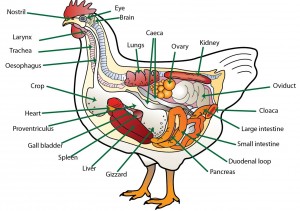Poultry Diseases
Gizzard and Crop Impaction
Also known as: Grass Impaction

The crop and the gizzard are organs in the digestive tract of birds, separated by the proventriculus which is often referred to as the true stomach. The crop is a part of the oesophagus in which chickens store food until ready for digestion. The proventriculus is where stomach acid, and digestive enzymes are secreted and the gizzard mixes the food with digestive fluids with the help of small stones ingested by the bird. Image source: www.poultryhub.org
Gizzard impaction is a particular problem associated with ranging chickens. This is caused by long grass, or other material such as plastic bags, becoming coiled into a plug in the gizzard (see image). Crop impaction can also occur, but is much less common.
The gizzard, an organ that is part of the digestive tract beneath the crop and is used to grind food by muscular contraction, is poorly developed in young birds. They are therefore not well prepared for the consumption of large volumes of grass. The muscles lining the walls of the gizzard develop only after a period of a week or more at grass (Christensen, 1995).
Gizzard impaction may eventually result in starvation if the bird is not treated. The coiled plug of grass restricts the movement of food into the duodenum.
Christensen (1998) describes how long “ropes” of twisted grass of up to 6cm in length resulted in mortality rates of up to 1% per week in free-range hens. On post-mortem, these ropes of grass were found extending into the duodenum from the gizzard. Egg quality, size and shell colour declined to unacceptable levels (Christensen, 1998).
Mortality from impaction (mainly grass) in a free-range situation has been shown to be higher in the New Hampshire breed compared with ISA brown and white leghorn breeds (Kjaer and Sørensen, 2002).
Control and Prevention of Gizzard Impaction
The provision of grit can significantly aid the functioning of the gizzard. Although most free-ranging hens will pick up small stones and grit, the provision of a supplementary source will be required for birds that are reluctant rangers, or in situations where the soil is lacking stones.
However, in certain situations the provision of grit will not necessarily prevent gizzard impaction, as poultry maintained on pasture with fibrous grass can suffer severe problems even when supplied with grit. Christensen (1998) advises that old and fibrous grass should be either removed after mowing or allowed to rot before poultry are introduced (Christensen, 1998).
Encouragement of early adaptation to a grass-based diet and ensuring adequate consumption of feed and water is recommended. Daily monitoring of the crop-fill is a useful procedure in that it allows confirmation of the proportion of chicks consuming feed and can give inexperienced poultry keepers feedback on the effectiveness of their brooding management. Further information can be found on the Poultry Site here.
Treating Gizzard Impaction
Although there is little veterinary guidance on the treatment of impaction of poultry, Christensen (1998) reported successful treatment with 3g of Epsom salts per 100 birds per day, plus 10-15ml of liquid molasses per bird fed as a wet mash for four days. Further energy and lubrication can be provided by the addition of vegetable oil. Most of the grass plugs will be passed out within the first two days of treatment and mortalities should stop. The molasses component of the treatment will aid the recovery of the birds (Christensen, 1998).
Banks (1979) recommends the use of a syringe to administer approximately half a tumbler of warm water to individual birds with this condition. By turning the bird upside down and gently massaging the crop may then release the mass of grassy material (Banks, 1979).
There will often be a build-up of fluid when the gizzard is impacted and if the bird is (briefly) inverted the fluid can be expelled, but without resolution of the blockage by the next day the fluid will be back. There is often damage to nerves around the gizzard or crop from the impaction and/or physical damage to these organs. Mycotoxins can also become an issue. A variety of treatments can be tried but this is often an incurable condition.
Surgery is an option, but the farm vet should be consulted.
Good Practice Based on Current Knowledge
- A source of grit should be supplied
- Birds should be kept on short, fresh grass, and older, mature and fibrous grass should be avoided
- Fibrous grass should be removed after mowing or allowed to rot before birds have access to the land.
- Remove nails and other potentially dangerous foreign bodies from house and range
- Good brooding management to encourage early adaptation to the diet and adequate consumption of feed and water is recommended


 American English
American English

Comments are closed.